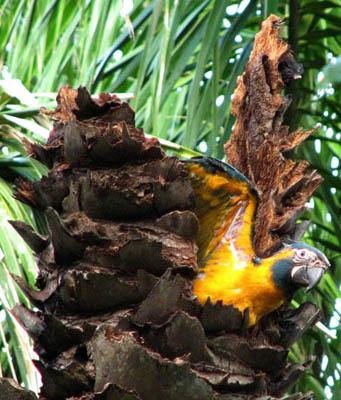Looking over the past few things I’ve posted I’m wondering if I’m depressing readers; nests failing, adults hemorrhaging, etc. It’s a nice change then to write about the first nest of the season to fledge young. I flew out to the area to verify it myself. Part of me was secretly hoping to actually see the chick fledge, something I’ve never seen in over six field seasons of watching macaw nests. For me it would be particularly rewarding to see it happen with a Blue-throat nest as this is the species I’ve spent the most time with and every chick that fledges into the wild is so valuable.
The chick from this nest was quite the tease with respect to witnessing its first flight. The top of this nest had broken off so I had a good view of the nestling as it would climb up to the top and exercise its wings. It reminded me a bit of a kid taking his first dive off the high diving board. The chick would teeter at the edge of the nest entrance leaning forward and spreading its wings, all the while receiving light caws of encouragement from its parents who were perched nearby.

When it reached that critical point where it would either fly or fall over, it would pull back, aborting its exit from the nest at the last moment. The batteries on my camera eventually died from filming this ritual of ‘almost fledging’ over the course of five days. On the morning of the sixth day I arrived at the nest tree to find no macaws around, adults or chick. And so the first flight of the macaw remains this elusive, mysterious event for me.
The fledging of this particular nest was significant on several levels. Occurring in mid-December, it’s the earliest fledging event we’ve seen so far. To do so, this pair started incubating in mid-August. For whatever reasons, most of the nests this season started earlier compared to past years. This is also the first time we’ve seen a motacu palm snag nest fledge successfully. Over the past three seasons all the past examples of this nest type have failed, most to predation, some to flooding, one even fell over. It’s good to know that these nests do work on occasion but we’ve seen that we really need to pro-actively management motacu nests to improve the probability of fledging success.
Something else happened during my visit to this area worth mentioning. One nest tree there has been occupied every year since we first started visiting in 2002. One pair has been periodically guarding it this season since mid-August. There have been periods where we thought it was active, as the female was spending long periods inside the nest but by mid-December still no eggs. This particular nest isn’t deep enough for my liking. It’s only about 15cm (6 in) deep, so when the female sits inside it, her tail feathers jut out of the entrance. In order to make the nest more difficult to predate, I decided to climb it to deepen the cavity. The strangest thing happened while I was up in the ropes at the nest entrance. The pair that was guarding the nest flew into the area, circled the tree once and perched in another tree nearby.
I’ve learned in the past that staring directly at wild animals usually frightens them off, so I ignored the pair and went on with my work, chiseling away pieces of wood from the base of the nest cavity. To my shock one of the pair flew to a perch in the nest tree, less than 2m (7ft) from my position. I tried to continue ignoring the bird but to be this close to a wild Blue-throat adult was too tempting. As I sneaked a glance over my shoulder the bird started to hang upside down in order to get a better look at what I was up to. Where was my camera at this spectacular moment? On the ground of course, eight meters below. After what seemed like an eternity, the macaw flew off to join its mate leaving me breathless. Blue-throats are usually so wary of human beings. I didn’t get the feeling this particular bird was trying to protect its nest. It would have been making lots of noise if that was the case. I got the feeling that it was merely curious and felt sufficiently safe to get that close to me.
As I mentioned before, we’ve been visiting this area for five years now, so maybe the birds recognize us and know we represent no threat to them. As much I’d like to have all the birds habituated to our presence around their nests, it’s preferable they all retain their fear of, and distance from, humans. As long as there are beautiful birds in this world there will always be people who will try to trap or shoot them.
































